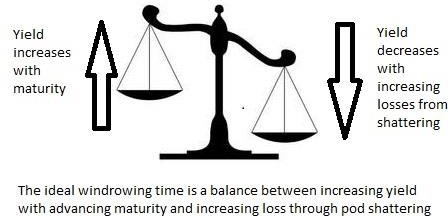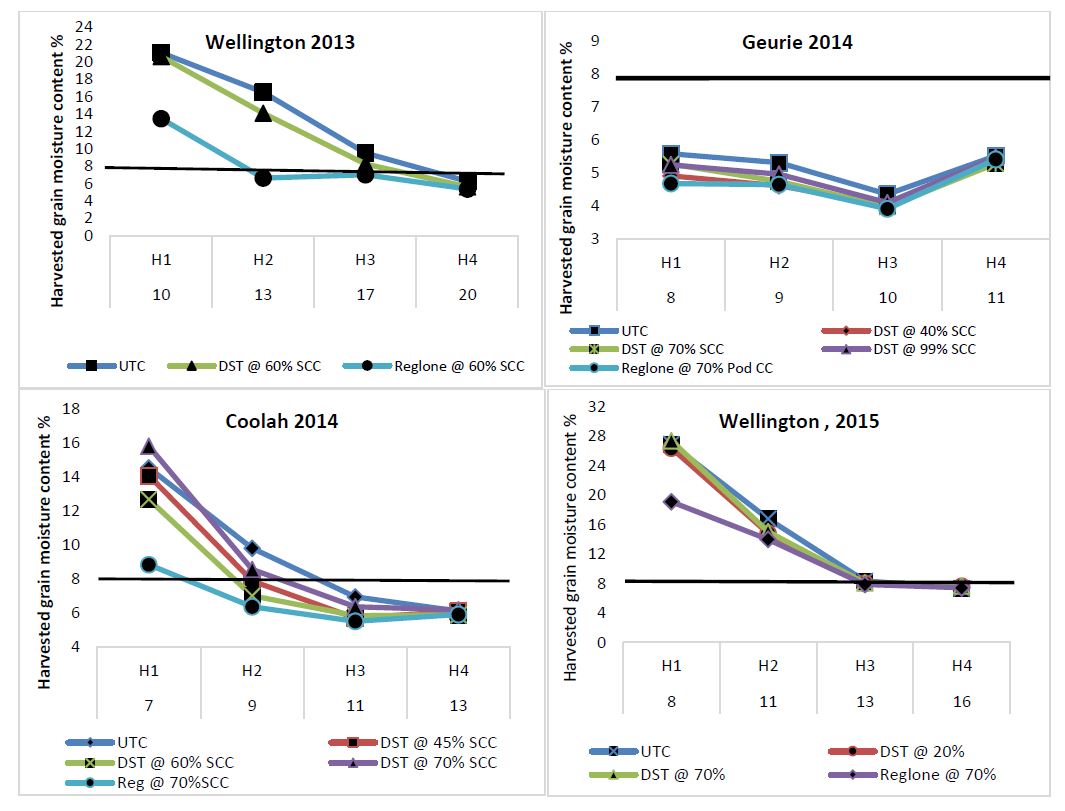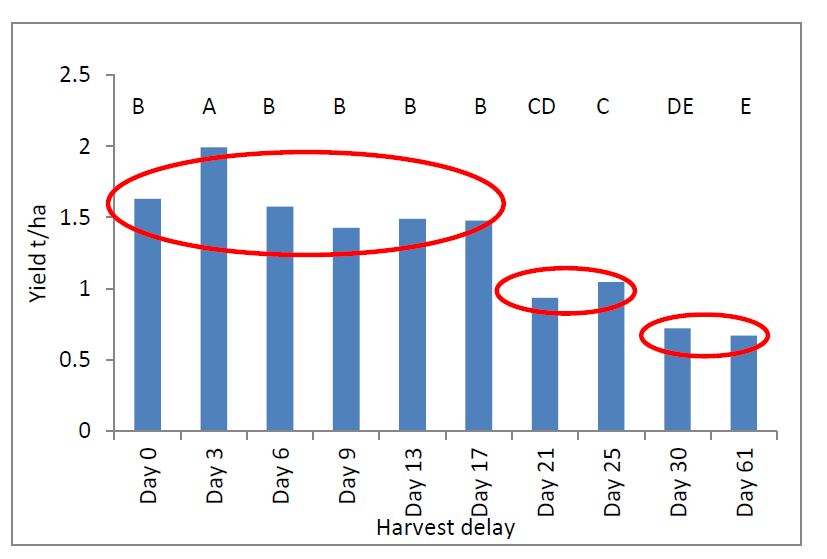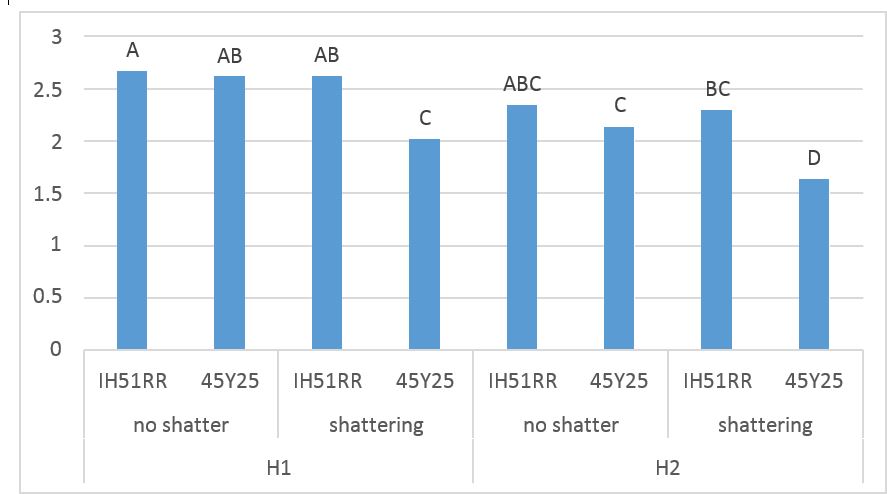Rethinking your approach to canola harvesting
Author: Maurie Street (Grain Orana Alliance) | Date: 20 Feb 2018
Take home messages
- Timing of windrowing of canola can have a huge impact on profitability through its influence on yield and oil%.
- Profit could be reduced by up to $50/day for every day that crops are windrowed before they are ready.
- The window for windrowing on time is relatively small.
- Direct heading of canola is a viable and comparable alternative to well-timed windrowing, but may easily outperform crops that are windrowed before they are ready.
- In contrast, the window for direct heading crops to maximise yield and profit may be much larger than those that are windrowed.
- Desiccation, other than that for weed control, in many cases will not significantly speed up crop maturity.
Background
Windrowing of canola in the central west of NSW has been the traditional approach adopted by most growers. Recent survey data collected in 2017 by Grain Orana Alliance (GOA), a GRDC Grower Solutions Group, indicates that a decade ago, between 65%and 80% of canola growers used windrowing exclusively (GOA, unpublished).
In 2009, GOA was asked to investigate if windrow timing (WRT) was potentially impacting on canola performance, in particular oil % of harvested grain, which can impact on crop profitability. In response, GOA established two trials in 2009 that compared different WRTs. In both trials, early windrowing resulted in significant yield penalties of up to 0.5t/ha, but only low levels of impact on oil% of the grain.
The outcomes from these two trials inspired many subsequent trials undertaken by GOA, not only investigating the impact of WRT, but investigating the fit of direct heading, the use of desiccants, the use of Pod Ceal™, and the impacts of delays in direct heading. More recently, the potential benefits of new canola varieties with increased tolerance to shattering (Bayer’s PodGuard™ varieties) were also trialled.
GOA has previously presented and published on these topics. The detailed presentations and papers can be found on either the GRDC or the GOA website. This paper aims to summarise the key findings and to present a case for growers to reconsider how they might approach harvesting canola in the future.
What is the ideal windrowing time?
WRT is the stage of crop maturity when the crop is cut and placed into windrows to be later harvested when the grain has dried down to a deliverable moisture content (DMC) of 8%. The crop stage is identified by the percentage of the seed that is changing colour. For example, the currently accepted recommendation for the timing of canola windrowing is: ’Windrowing should commence when 40% to 60% seed in the middle third of the main stem has changed colour from green to brown, black or red.’(Carmody, 2009).
The recommendation states that it is the seed from the middle third of the main stem. References in this paper to seed colour change (SCC) refer to this section of the crop.
The seed changing colour should be thought of as an indicator of those seeds reaching physiological maturity. At this point, seed has reached its full potential in terms of seed size and oil content. Prior to this point, the seed is still growing (increasing in size) which is contributing to increasing yields and oil content. The recommendation of 40% to 60% colour change infers that only 40% to 60% of the seed in the referenced part of the crop is mature and reached its full size, while the remaining part of the crop is still growing. Any seed not mature at the time of windrowing will have any further growth or accumulation of oil stopped abruptly which will see potential further increases in yield or oil% forgone. The earlier the timing, the more yield and oil% forgone — the later the timing, the greater the potential yield that is realised.
However, what also occurs with increasing levels of crop maturity is that seed pods dry out and become increasingly brittle. Windrowing involves cutting the canola plants off at their stems and moving the plant tops into a ’windrow’. This process can be aggressive and often results in pods impacting other pods and plants or parts of the windrowing machinery. This can break off and/or break open pods releasing the pods/seed onto the ground where they will not be captured by the harvester.

Figure 1. Illustration of the balance needed between increasing yields and increasing potential losses with advancing maturity.
An ideal WRT should be timed to maximise the increasing crop yield, but not too late as to reduce harvestable yield by shattering out canola either before, but more likely during the windrowing process.
So what did we find?
Large scale, replicated field trials run by GOA over three years showed that WRT could have an impact on oil%, but it was often quite small and not significantly different. The effect of WRT on crop yield, however, was often much larger, not only in magnitude but economic impact. One of the first trials undertaken by GOA at Coonamble in 2009 showed that delaying WRT from 10% SCC to 70% SCC, or eight days, increased yields by 500kg/ha. The increase represented a 30% yield improvement and at current (time of reporting (November 2017)) canola prices ($500 ex farm) would be worth $250/ha excluding GST.
More recently (2015, 2016 and 2017) trials by NSW DPI under the GRDC co-funded ’Optimised Canola Productivity’ project have looked more closely at the impact WRT can have on yields and oil%. This work has shown, in some cases, that yield impacts were even greater than those seen in GOA’s trials. Yield increases of more than 2t/ha were seen from the earliest WRT, less than 5% SCC, to the latest at 100% SCC at Tamworth in 2016. The influence of WRT on oil% was also much higher in these trials with increases of more than 7% resulting from delays in WRT (Graham et al. 2017).
The consistent message from both GOA and NSW DPI is that WRT earlier than the current recommended timings of 40% to 60% SCC has universally resulted in significant yield penalties. Some of the most stark yield penalties from windrowing too early were seen in the NSW DPI trials at Trangie, Edgeroi and Tamworth in 2016 where reductions of 48%, 55% and 32%, respectively, were seen (Graham et al. 2016). Yield penalties from the larger scale field trials run by GOA which were commercially windrowed at the specific levels of SCC only ranged from 12% to 22% which are still substantial losses.
The trials have also demonstrated the potential to increase yields further by delaying WRT past the recommended timings. The GOA trial at Coonamble showed a further 16% increase in yield (280kg/ha) from only a five day delay in WRT from 50% SCC to 70% SCC (Street, 2014). Delaying WRT at Trangie in 2016 from approximately 60% SCC to the 100% SCC increased yields by approximately 800kg/ha (Graham et al. 2017). A number of other trials also support these findings, where delaying WRT past 60% SCC tends to increase yields. This outcome is not unexpected given that up to 100% SCC, some immature seeds within the crop are still developing and so could contribute to yield. The question remains, however, at what point do the losses from pod or seed shatter negate any further increases in yield?
How late is too late to windrow?
GOA undertook four trials that investigated the effects of delaying WRT past the current recommendations. These trials used commercial windrowers and headers and reported harvested yields. As such, they take into account the potential losses from delayed windrowing. In these trials there was either an increase in yields or trends to increase, but no decline in harvested yields even where WRT was delayed up to 95% SCC. This is not to say that delayed WRT did not result in increased pod shattering, but any losses were compensated by increases in yields from other more immature parts of the plant.
As the NSW DPI trials were assessed by hand cuts from small plots, shattering seed loss from delayed WRT was not taken into account and the reported yields are somewhat theoretical. But given the lack of any measurable downturn in yields in the GOA trials with delays of up to 95% SCC, the yield gains demonstrated in the NSW DPI trials might only be reduced by excessive pod shatter at the very late end of the range of WRT investigated.
This theory was confirmed by a GOA trial in Wellington, NSW, where a measurable downturn in yield of 250kg/ha resulted from a delayed WRT. However, the delay was measured as seven days after 100% SCC and so represented an extreme case of late windrowing.
When should I windrow?
The simple message from this work is that in the very least growers should strive to windrow at the current recommended timings of 40% to 60% SCC as significant yield and oil% penalties will occur by going earlier. However, there is a strong case to suggest growers should work to the later end of this range of SCC or even beyond, if seasonal conditions are supportive of continued seed fill, as in many cases yields have increased further and there has been little evidence that increased pod shattering is resulting in any downturns in harvestable yields.
What is driving the later timing of windrowing?
Plant populations have generally reduced over the years. Street (2014) first suggested that with lower plant populations, proportionally less yield is carried by the main stem where WTR is assessed. Crop maturity on branches is often behind that of the main stem and hence our current approach to assessing SCC on the main stem for windrowing was over-estimating crop maturity as compared to crops with higher plant populations.
NSW DPI’s more recent research with its increased precision has shown this to be true. It is also suggesting assessing the whole plant for a measure of maturity rather than just the main stem.
Varieties have also evolved. Variety trials are often not windrowed but desiccated and direct headed. Varieties susceptible to pod shatter would suffer a higher level of yield damage resulting in a yield handicap, reducing the likelihood that any such varieties would progress to commercialisation.
This also means varieties of 20 to 30 years ago would have been more likely to shatter at an earlier level of SCC, tipping the scale towards an earlier windrowing time than it would be with today’s varieties.
Where does direct heading fit?
Given that windrowing has the potential to reduce yields because it is done before all seed has matured, does direct heading have potential to capture higher yields? GOA ran four trials which have showed that yields from direct headed situations have generally matched the yields of a well-timed windrowing. If compared to that of an ill-timed windrowing, i.e. too early or too late, the direct heading outperformed the windrowed treatment.
GRDC has produced a Direct heading factsheet that examines many of the pros and cons of direct heading. The document suggests that on top of yield advantages, growers should also consider the additional benefits including the elimination of windrowing costs, applicability for heavy lodged crops that cannot be windrowed and for lighter crops where small windrows may be unstable in windy conditions.
How does timing of harvest vary between direct headed or windrowed crops? And will desiccation help alleviate any differences?
One common concern for growers when considering direct heading is the perceived delay in the commencement of harvesting of direct headed crops. It is thought that compared to windrowed crops, ones left for direct heading take longer to dry down to acceptable grain moisture content (GMC) before harvesting can commence.
One option to potentially manage this issue in direct headed crops is to apply a desiccant herbicide to the crop ahead of harvest to speed up the ripening process. Reglone® has been registered for this purpose for some time but its cost, difficulties in application and perceived unreliability often deter many from its use.
More recently, a glyphosate formulation, weedmaster® DST® marketed by Nufarm has been registered for use in canola for pre-harvest application. While the main label claim is for pre-harvest weed control, it is also registered as a ’harvest aid’, suggesting that it may also speed up the ripening process.
Over three years GOA has run four trials investigating the relative effectiveness of weedmaster® DST® and Reglone®, in reducing GMC to facilitate earlier harvesting.
The key finding from this work was that Reglone®, when applied as a desiccant to canola, showed some advantage in bringing GMC down quicker than natural ripening. At Wellington in 2013, the Reglone® treatment would have allowed harvest to start approximately five days earlier. In the other locations, the GMC of all treatments dropped below 8% within two days, hence the advantage of Reglone® was much less or not even apparent as illustrated in Figure 2.

Figure 2. Harvested GMCs in response to application of Reglone® (Reg) or weedmaster® DST® (DST) at differing levels of seed colour change, as assessed at four different harvest timings (H1, H2, H3, H4). Numbers under the harvest timings indicate the number of days since the Reglone® application (approximately 70% SCC).
Weedmaster® DST® applied pre-harvest also showed little practical benefit at bringing harvest forward. Except for one DST treatment at Coolah in 2014, there was no significant difference in GMC at any harvest timing between any DST treatment and the untreated crop.Further details of the trials can be found at Grain Orana Alliance.
An interesting observation in these trials was the rate at which the crops ripened without any desiccation and the relevance this may have to potential time differences between harvesting of a windrowed crop and direct headed one. Reglone® in the trials detailed above was applied at approximately 70% SCC and in light of recent research, this crop stage is arguably an acceptable windrowing time. It can be seen in the graphs above, the time that it takes the untreated crops to dry down the 8% GMC in relation to 70% SCC.
Both Wellington trials took only 13 or 17 days for the untreated to reach 8% moisture but in 2014, Geurie reached 8% moisture in less than eight days and Coolah within 10 days. Past experiences suggest windrows often cure for at least 10-14 days most years and so would suggest the time to harvest a direct headed crop would be within days of one that is windrowed and not weeks as often thought could be the case.
The view of longer delays to this may be brought about through early windrowing. The earlier a crop is windrowed, the sooner it is dry enough to harvest relative to a crop left standing to ripen naturally. It could be suggested that in many cases if growers do experience lengthy delays in commencement of direct heading in comparison to similar ones around, it could indicate windrowing has commenced too early, which we now know could be incurring significant yield penalties.
Windrowing allows me to get started on harvest earlier so as not to interfere with harvesting of my other crops
Many growers argue their preference for windrowing crops as it hastens harvesting, however as it is evidenced above, the difference may not be as large as some think if windrowing at the correct timings. That being said, windrowing may offer a number of days which may be useful, but for many growers this may still not be enough. If growers choose windrowing early to result in more available days to complete harvesting, it should be remembered this could come at a significant cost. Numerous trials have shown that premature windrowing could be costing growers up to $50/ha/day.
Regardless of whether crops are windrowed at the more appropriate later timings or direct harvested, growers should consider changing the traditional harvest order. Canola does not always have to come off first.
Delayed direct heading and pod shattering
One GOA trial has shown that yields in direct headed crops can be relatively stable for a considerable period after the crop is ready to harvest. Results of a trial conducted in 2013, illustrated in Figure 3, demonstrated that the yield did not decline for two weeks after the initial harvest timing. At this point, there was a major weather event that resulted in yield declines, after which the yields plateaued again, and this pattern recurred. This suggests that in this situation, yield decline when harvesting is delayed tends to be stepped rather than linear and that shattering yield losses are most likely a function of weather extremes, which are fortunately infrequent, but unfortunately unpredictable in their nature.

Figure 3. Harvested grain yields in response to delays in direct heading, Wellington 2013.
PodGuard™ canola promises of enhanced shatter tolerance
Recently Bayer has bred a unique genetic trait ’PodGuard™’ into selected new canola varieties offering increased tolerance to shattering. This trait may allow growers to either delay WRT until later stages of crop maturity to capture higher yields or allow growers to have confidence that crops left to direct head do not shatter before harvesting.
GOA, in conjunction with Bayer, tested shattering tolerance of PodGuard™ against a non PodGuard™ variety in a trial conducted in 2015. A severe shattering event was simulated consisting of dragging a two inch steel pipe twice through the podding zone.
At the first harvest timing (H1) without the simulated shattering, the yields of the two varieties are comparable. However, when the simulated shattering was applied, only the yield of the variety 45Y25 was affected, reducing yields by approx. 600kg/ha. Delaying harvest by 14 days (H2) resulted in no statistically significant yield decline in the PodGuard™ variety, however the yield of the 45Y25 was reduced by approx. 500kg/ha. Combining the simulated shattering event with the delay in harvest, the 45Y25 suffered almost a further 500kg/ha yield loss, while the PodGuard™ experienced no loss of yield (Figure 4).

Figure 4. Harvested yield in response to harvest timing and simulated shattering by variety, Wellington 2015
During this trial, measurements were made to quantify the source and timing of the losses encountered. Details of these are covered in the full trial report on the GOA website5.
In summary, the PodGuard™ variety IH51RR has shown good potential to resist shattering from delays in direct heading or shattering events such as high winds or hail.
Pulling it all together
Windrowing will remain popular with many growers for a number of reasons, however growers should seriously consider windrowing toward the latter end of current recommended timings. There is mounting evidence to suggest that windrowing up to a conservative timing of 70% to 80% SCC can result in even further increases in yields and oils, as pod shattering at this crop stage is likely to be much less than current perceptions. Even if some shattering loss is apparent, it should be remembered that increases in yields from the fuller maturation of the crop will often more than compensate.
Direct heading of canola is a worthy alternative to windrowing crops and much of the negative connotations of the past are not as common as often thought. Direct heading will allow for the whole crop to reach its full potential yield and oil%. Trial work suggests that it will yield as well as a correctly timed windrowed crop. If the alternative is to windrow too early or too late because of weather complications or availability of a windrower, direct heading may be the best.
Concern over rapid yield loss with delay to direct heading has not really been demonstrated in trial work or with commercial experience which has often shown yields to be quite stable post crop maturity. With ever improving varieties or PodGuard™ varieties, concerns could be even further allayed.
Time differences between windrowed and direct headed crops may also not be as different as thought, provided windrowing of crops is done at more appropriate stages. If growers choose to windrow early to finish early, that decision will come at a significant price paid in terms of decreased yield and oil%.
An interesting consideration is that it has been shown that yield impacts from incorrect WRT to amount to losses of up to $50/ha/day, and that the rate of change in SCC can be very rapid. The opportunity to windrow is quite small, maybe as little as one to three days. In contrast, the time to direct head a crop may be much longer.
GOA’s trial work on desiccation products has shown little advantage in terms of closing the gap on harvest timing, with Reglone®, while not consistent, performing better than weedmaster® DST®, but overall neither achieving practically useful results.
Useful resources
Factsheet - Stewardship for pre-harvest application of herbicides in winter crops
References
Carmody, Paul (2009). Canola best practice management guide for south-eastern Australia- Chapter 14, Windrowing and harvesting
Graham R, Jenkins L, Brill R, Hertel K, McCaffery D (2016). Assessing seed colour change for improved harvest decisions in canola: include branches with the main stem. In proceedings 19th Australian Research Assembly on Brassicas. Melbourne, Australia 3-6 October 2016
Hertel K (2013). Canola: the economics and physiology of the timing of windrowing.
Treet M (2014). To windrow or not to windrow in 2014? This is the question, but if so, when?
Acknowledgements
The research undertaken as part of this project is made possible by the significant contributions of growers through both trial cooperation and the support of the GRDC — the author would like to thank them for their continued support.
Contact details
Maurie Street
Grain Orana Alliance
PO Box 2880 Dubbo NSW 2830
0400 066 201
Maurie.street@grainorana.com.au
GRDC Project Code: GOA00002,
Was this page helpful?
YOUR FEEDBACK
